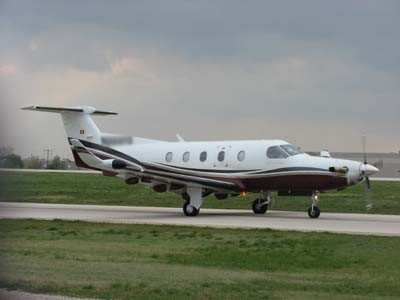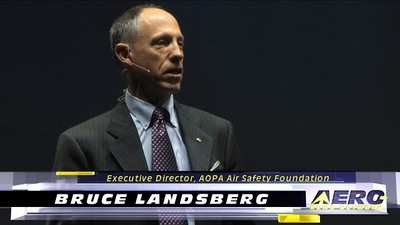ASF Cautions Against "Jumping To Conclusions"
 ANN REALTIME UPDATE 03.25.09 0001 EDT: Investigators
with the National Transportation Safety Board recovered a piece of
evidence Tuesday they hope might shed new light on why a Pilatus
PC-12/45 crashed near an airport in Butte, MT this weekend: the
engine performance recorder.
ANN REALTIME UPDATE 03.25.09 0001 EDT: Investigators
with the National Transportation Safety Board recovered a piece of
evidence Tuesday they hope might shed new light on why a Pilatus
PC-12/45 crashed near an airport in Butte, MT this weekend: the
engine performance recorder.
The device, reports The New York Times, measures engine data
once every minute, and might disclose whether the aircraft's Pratt
& Whitney Canada PT6A-67B turboprop powerplant suffered any
problems that might have led to the accident.
Such a discovery would appear to be a longshot, but with little
other information to go on -- like many small corporate planes, the
PC-12 was not equipped with flight data or cockpit voice recorders
-- investigators hope to catch a break.
Acting NTSB Chairman Mark Rosenker said the Board will consider
numerous possible scenarios in working to determine why the
aircraft crashed, claiming the lives of the 14 people onboard.
Among the many questions is why the plane's pilot opted to divert
to Butte when the aircraft was within 20 minutes of its planned
destination of Bozeman.
"There are some interesting attributes to this [investigation].
One is the question of the 25,000-foot request for diversion to
come to Butte," Rosenker said. "There are a lot of questions, but
it begins with that question. That's where we believe -- that's
where we're beginning to look at things."
The Los Angeles Times reports investigators also want to know
why the plane impacted where it did: about 500 feet away from its
intended landing point, nearly abeam midfield. Further, the
aircraft wasn't fully configured for landing -- investigators say
the landing gear was down, but flaps were not deployed.
 Though this -- like nearly every theory at this point -- is
pure speculation, the NTSB says the impact point might indicate the
pilot was attempting to turn a very tight downwind for Runway 33 at
Bert Mooney Airport (BTM). That turn may have been complicated by
the weight of the passengers and baggage onboard the plane... or
possibly ice accumulated on the airframe from descending through a
freezing layer on approach to the airport.
Though this -- like nearly every theory at this point -- is
pure speculation, the NTSB says the impact point might indicate the
pilot was attempting to turn a very tight downwind for Runway 33 at
Bert Mooney Airport (BTM). That turn may have been complicated by
the weight of the passengers and baggage onboard the plane... or
possibly ice accumulated on the airframe from descending through a
freezing layer on approach to the airport.
The NTSB also noted Tuesday that
an airworthiness directive was issued by the FAA two weeks
ago, requiring PC-12 operators to check whether the
rear stick-pusher cable clamp had shifted forward on the elevator
cable, a condition that could hamper pitch control authority.
It's not clear whether that AD had been complied with on the
accident aircraft, as the directive doesn't go into
effect until March 30, and gives operators 150 flight hours to
comply. However, NTSB Investigator-In-Charge Dennis Hogenson told
the Associated Press investigators were able to establish control
continuity at the crash site, and at this point it's unlikely that
issue was a factor in Sunday's crash.
Original Report
03.24.09 1000 EDT: As investigators worked
Monday to identify the victims of
Sunday's downing of a Pilatus PC-12/45 near Bert Mooney
Airport (BTM), speculation about possible causes for
the crash continued to run the gamut -- including theories the
aircraft (type shown below) was overweight and/or out of CG range,
that it may have suffered some kind of mechanical failure, or that
the plane picked up severe airframe icing on its descent into
Butte, MT.

Such speculation is the norm when dealing with a high-profile
aviation accident... particularly when the crash attracts the
attention of the general media, and involves the loss of families
or children. Whether that's right or wrong is a discussion for
another time -- though the AOPA Air Safety Foundation cautioned
Tuesday against anyone jumping to conclusions regarding causes,
when the investigation has barely started.
"It's important to remember that except for the extremely rare
single-point catastrophic failure, aviation accidents are almost
invariably the result of a chain of events and decisions," said Air
Safety Foundation President Bruce Landsberg. "The National
Transportation Safety Board is extremely good at accident
reconstruction, but it will take them months to find and then
unravel all the links in this accident's chain."
Landsberg's comments followed statements made by a number of
aviation analysts Monday. John Goglia, a former National
Transportation Safety Board official, told The Associated Press
icing may very well emerge as a leading theory among investigators,
given weather conditions at the time and witness accounts the plane
nosedived into the ground.
 "It's Buffalo all over again, or it
could be," Goglia said, referring to
last month's downing of a Bombardier Q400 regional
aircraft as it approached Buffalo, NY, that many
believe was at least partly due to significant airframe icing.
(Of course, it's also worth noting THAT investigation is still
underway, as well -- Ed.)
"It's Buffalo all over again, or it
could be," Goglia said, referring to
last month's downing of a Bombardier Q400 regional
aircraft as it approached Buffalo, NY, that many
believe was at least partly due to significant airframe icing.
(Of course, it's also worth noting THAT investigation is still
underway, as well -- Ed.)
Officials have confirmed the PC-12 had 14 individuals onboard,
seven adults and seven children. Those children ranged in age from
1 to 9... meaning that despite
having more persons onboard the plane than number of seats
available -- the accident aircraft was in a commuter
configuration with either 10 or 11 pilot and passenger seats,
according to reports -- it's likely some of those youths were
seated on adult passengers' laps, which FAA regs allow up to the
age of 2.
It's still too soon to determine whether the aircraft was
operating within its specified weight range. Investigators may also
never know whether the aircraft was within its accepted
center-of-gravity range, particularly as fuel burned off during the
flight.
"I'm convinced, even at this early stage, that one of the areas
they need to look at the closest is weight and balance," said ABC
News aviation consultant John Nance, adding it's possible the
adults or children onboard were moving about the cabin during the
approach to BTM, possibly throwing off the aircraft's weight
balance at a critical moment.
"The fact that you've got children onboard, they may see
something out of the airplane at the last minute," Nance said.
"People unstrap their seat belts, get up and move, and your center
of gravity could shift."
Officials have identified the plane's pilot, as well as the
owner of the PC-12. Buddy Summerfield, 65, was a former military
pilot with 2,000 hours in the PC-12, according to authorities.
Summerfield was apparently flying three families on a skiing trip,
for the plane's owner, Dr. Bud Feldkamp.
Feldkamp was not onboard the aircraft... but he said two of his
daughters, their husbands and five of his grandchildren were
onboard the plane.
Investigators also aren't sure why Summerfield opted to divert
to Butte over the plane's intended destination of Bozeman. No
emergency call was made; Nance said it's possible Summerfield opted
to land sooner to give his passengers a bathroom break... a
plausible theory, given the plane was airborne for 2 1/2 hours
prior to the crash, and the commuter-configured PC-12 was likely
not equipped with a lavatory.

During press conferences Monday, acting NTSB Chairman Mark
Rosenker stressed the investigation was only just beginning. "This
will be a long and tedious investigation, extremely thorough," he
said. "We will look at every factor which could affect the
performance of this aircraft."
"To say that icing is becoming the lead focus is not true at
this point," NTSB spokesman Keith Holloway told The Associated
Press. "We're looking at mechanical issues. We're looking at
weather. We're looking at the structure of the aircraft. We're
looking at human performance, weight and balance issues."
Those sentiments were echoed Tuesday by ASF's Landsberg
(shown above). "The briefings and the preliminary report are
nothing more -- or less -- than a listing of the facts collected,"
said Landsberg. "They give no relative weight to any of the facts,
nor do they draw any conclusions about possible causes."
 ANN's Daily Aero-Linx (04.15.24)
ANN's Daily Aero-Linx (04.15.24) Classic Aero-TV: 'No Other Options' -- The Israeli Air Force's Danny Shapira
Classic Aero-TV: 'No Other Options' -- The Israeli Air Force's Danny Shapira Aero-News: Quote of the Day (04.15.24)
Aero-News: Quote of the Day (04.15.24) Airborne 04.16.24: RV Update, Affordable Flying Expo, Diamond Lil
Airborne 04.16.24: RV Update, Affordable Flying Expo, Diamond Lil ANN's Daily Aero-Term (04.16.24): Chart Supplement US
ANN's Daily Aero-Term (04.16.24): Chart Supplement US







